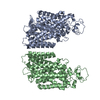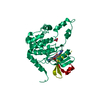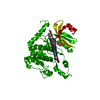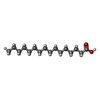+ Open data
Open data
- Basic information
Basic information
| Entry | Database: PDB / ID: 7d10 | ||||||
|---|---|---|---|---|---|---|---|
| Title | Human NKCC1 | ||||||
 Components Components | Solute carrier family 12 member 2 | ||||||
 Keywords Keywords | MEMBRANE PROTEIN / transporter | ||||||
| Function / homology |  Function and homology information Function and homology informationpositive regulation of cell volume / positive regulation of aspartate secretion / transepithelial ammonium transport / regulation of matrix metallopeptidase secretion / cell body membrane / metal ion transmembrane transporter activity / inorganic anion import across plasma membrane / inorganic cation import across plasma membrane / chloride:monoatomic cation symporter activity / sodium:potassium:chloride symporter activity ...positive regulation of cell volume / positive regulation of aspartate secretion / transepithelial ammonium transport / regulation of matrix metallopeptidase secretion / cell body membrane / metal ion transmembrane transporter activity / inorganic anion import across plasma membrane / inorganic cation import across plasma membrane / chloride:monoatomic cation symporter activity / sodium:potassium:chloride symporter activity / Cation-coupled Chloride cotransporters / potassium ion transmembrane transporter activity / transepithelial chloride transport / intracellular chloride ion homeostasis / ammonium transmembrane transport / negative regulation of vascular wound healing / sodium ion homeostasis / ammonium channel activity / chloride ion homeostasis / cell projection membrane / cellular response to chemokine / T cell chemotaxis / potassium ion homeostasis / intracellular sodium ion homeostasis / sodium ion import across plasma membrane / cell volume homeostasis / cellular response to potassium ion / hyperosmotic response / regulation of spontaneous synaptic transmission / gamma-aminobutyric acid signaling pathway / maintenance of blood-brain barrier / potassium ion import across plasma membrane / intracellular potassium ion homeostasis / lateral plasma membrane / transport across blood-brain barrier / monoatomic ion transport / sodium ion transmembrane transport / basal plasma membrane / cytoplasmic vesicle membrane / chloride transmembrane transport / cell periphery / cell projection / Hsp90 protein binding / extracellular vesicle / protein-folding chaperone binding / cell body / basolateral plasma membrane / neuron projection / apical plasma membrane / neuronal cell body / protein kinase binding / extracellular exosome / membrane / plasma membrane Similarity search - Function | ||||||
| Biological species |  Homo sapiens (human) Homo sapiens (human) | ||||||
| Method | ELECTRON MICROSCOPY / single particle reconstruction / cryo EM / Resolution: 3.52 Å | ||||||
 Authors Authors | Zhang, S. / Yang, M. | ||||||
 Citation Citation |  Journal: Commun Biol / Year: 2021 Journal: Commun Biol / Year: 2021Title: The structural basis of function and regulation of neuronal cotransporters NKCC1 and KCC2. Authors: Sensen Zhang / Jun Zhou / Yuebin Zhang / Tianya Liu / Perrine Friedel / Wei Zhuo / Suma Somasekharan / Kasturi Roy / Laixing Zhang / Yang Liu / Xianbin Meng / Haiteng Deng / Wenwen Zeng / ...Authors: Sensen Zhang / Jun Zhou / Yuebin Zhang / Tianya Liu / Perrine Friedel / Wei Zhuo / Suma Somasekharan / Kasturi Roy / Laixing Zhang / Yang Liu / Xianbin Meng / Haiteng Deng / Wenwen Zeng / Guohui Li / Biff Forbush / Maojun Yang /   Abstract: NKCC and KCC transporters mediate coupled transport of Na+K+Cl and K+Cl across the plasma membrane, thus regulating cell Cl concentration and cell volume and playing critical roles in transepithelial ...NKCC and KCC transporters mediate coupled transport of Na+K+Cl and K+Cl across the plasma membrane, thus regulating cell Cl concentration and cell volume and playing critical roles in transepithelial salt and water transport and in neuronal excitability. The function of these transporters has been intensively studied, but a mechanistic understanding has awaited structural studies of the transporters. Here, we present the cryo-electron microscopy (cryo-EM) structures of the two neuronal cation-chloride cotransporters human NKCC1 (SLC12A2) and mouse KCC2 (SLC12A5), along with computational analysis and functional characterization. These structures highlight essential residues in ion transport and allow us to propose mechanisms by which phosphorylation regulates transport activity. | ||||||
| History |
|
- Structure visualization
Structure visualization
| Movie |
 Movie viewer Movie viewer |
|---|---|
| Structure viewer | Molecule:  Molmil Molmil Jmol/JSmol Jmol/JSmol |
- Downloads & links
Downloads & links
- Download
Download
| PDBx/mmCIF format |  7d10.cif.gz 7d10.cif.gz | 182.5 KB | Display |  PDBx/mmCIF format PDBx/mmCIF format |
|---|---|---|---|---|
| PDB format |  pdb7d10.ent.gz pdb7d10.ent.gz | 125.9 KB | Display |  PDB format PDB format |
| PDBx/mmJSON format |  7d10.json.gz 7d10.json.gz | Tree view |  PDBx/mmJSON format PDBx/mmJSON format | |
| Others |  Other downloads Other downloads |
-Validation report
| Summary document |  7d10_validation.pdf.gz 7d10_validation.pdf.gz | 923.9 KB | Display |  wwPDB validaton report wwPDB validaton report |
|---|---|---|---|---|
| Full document |  7d10_full_validation.pdf.gz 7d10_full_validation.pdf.gz | 865.4 KB | Display | |
| Data in XML |  7d10_validation.xml.gz 7d10_validation.xml.gz | 29.4 KB | Display | |
| Data in CIF |  7d10_validation.cif.gz 7d10_validation.cif.gz | 43.6 KB | Display | |
| Arichive directory |  https://data.pdbj.org/pub/pdb/validation_reports/d1/7d10 https://data.pdbj.org/pub/pdb/validation_reports/d1/7d10 ftp://data.pdbj.org/pub/pdb/validation_reports/d1/7d10 ftp://data.pdbj.org/pub/pdb/validation_reports/d1/7d10 | HTTPS FTP |
-Related structure data
| Related structure data |  30542MC  7d14C M: map data used to model this data C: citing same article ( |
|---|---|
| Similar structure data |
- Links
Links
- Assembly
Assembly
| Deposited unit | 
|
|---|---|
| 1 |
|
- Components
Components
| #1: Protein | Mass: 131583.422 Da / Num. of mol.: 2 Source method: isolated from a genetically manipulated source Source: (gene. exp.)  Homo sapiens (human) / Gene: SLC12A2, NKCC1 / Production host: Homo sapiens (human) / Gene: SLC12A2, NKCC1 / Production host:  Homo sapiens (human) / References: UniProt: P55011 Homo sapiens (human) / References: UniProt: P55011#2: Chemical | ChemComp-PLM / Has ligand of interest | N | |
|---|
-Experimental details
-Experiment
| Experiment | Method: ELECTRON MICROSCOPY |
|---|---|
| EM experiment | Aggregation state: PARTICLE / 3D reconstruction method: single particle reconstruction |
- Sample preparation
Sample preparation
| Component | Name: human NKCC1 / Type: COMPLEX / Entity ID: #1 / Source: RECOMBINANT |
|---|---|
| Source (natural) | Organism:  Homo sapiens (human) Homo sapiens (human) |
| Source (recombinant) | Organism:  Homo sapiens (human) Homo sapiens (human) |
| Buffer solution | pH: 7.4 |
| Specimen | Embedding applied: NO / Shadowing applied: NO / Staining applied: NO / Vitrification applied: YES |
| Vitrification | Cryogen name: ETHANE |
- Electron microscopy imaging
Electron microscopy imaging
| Experimental equipment |  Model: Titan Krios / Image courtesy: FEI Company |
|---|---|
| Microscopy | Model: FEI TITAN KRIOS |
| Electron gun | Electron source:  FIELD EMISSION GUN / Accelerating voltage: 300 kV / Illumination mode: FLOOD BEAM FIELD EMISSION GUN / Accelerating voltage: 300 kV / Illumination mode: FLOOD BEAM |
| Electron lens | Mode: BRIGHT FIELD |
| Image recording | Electron dose: 50 e/Å2 / Film or detector model: GATAN K2 SUMMIT (4k x 4k) |
- Processing
Processing
| CTF correction | Type: PHASE FLIPPING AND AMPLITUDE CORRECTION |
|---|---|
| 3D reconstruction | Resolution: 3.52 Å / Resolution method: FSC 0.143 CUT-OFF / Num. of particles: 80000 / Symmetry type: POINT |
 Movie
Movie Controller
Controller













 PDBj
PDBj






